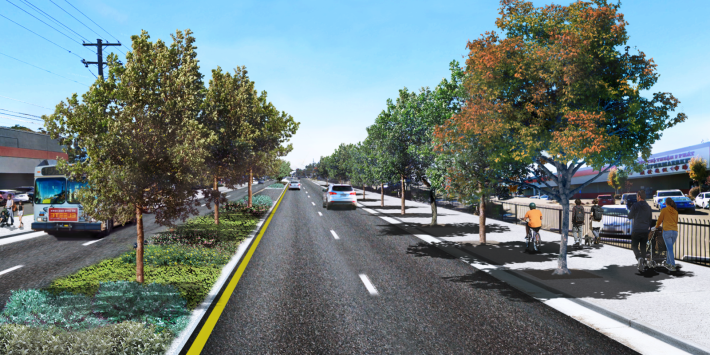Anyone who's heard the perennial earworm "(Get Your Kicks on) Route 66" knows a little about America's long history of building highways. But what they might not know is just how many of those vintage roads have survived to this day, evolving slowly into many communities' de facto Main Streets — even as they remained deadly for anyone outside a car.
Fixing these "legacy highways" — or "orphan highways," as they're sometimes called — has been a driving focus of Rep. Earl Blumenauer's career for more than 20 years, beginning with legislation he introduced in 2003 that would have provided more than $850 million in today's dollars to transform highways that are "frozen in time."
Now, the federal Department of Transportation has answered that call in a novel way: by making it crystal clear that states can already leverage 27 different federal programs in the Bipartisan Infrastructure Law to transform these roads with traffic calming measures, wider sidewalks, bike lanes and more. Twelve of those programs are "formula" grants, which means a certain amount of money is guaranteed to each state based on a DOT calculation, and states don't even need to compete for the funds.
"People aren't fighting to preserve [these roads] in their current state," Blumenauer told Streetsblog. "I've had these conversations literally around the country, as well as around my home state of Oregon — people are frustrated with the lack of resources. They're frustrated with road designs that don't match up with current needs. They're frustrated that [those designs] inhibit economic development. ... This is an opportunity for us to harmonize these efforts, to do it better, and to use federal resources at a time when there are unprecedented opportunities for federal resources."



Blumenauer knows firsthand how frustrating those fights can be.
In his own district, Portland advocates have been fighting for decades for changes along the notoriously dangerous 82nd Avenue, which was once a dirt road running through a rural area well beyond city limits.
As the City of Roses annexed its nearby suburbs, those city limits began to shift, and 82nd Avenue became a vital artery through the heart of Portland proper — and eventually, a designated state highway. Even after a nearby interstate was constructed to bypass it, though, both roads were still dominated by fast-moving cars — except now, 82nd was flanked with businesses and services that tempted people to walk and bike there, too.
That Frankenstein of a human-centered street and a car-centered, highway-style road is often referred to as a "stroad" — and state highway agencies aren't big fans of them either, since all those pesky pedestrians and stoplights make legacy highways highly inefficient at moving cars. The Oregon DOT relinquished control of 82nd in 2022, opening the door for the city to redesign it.
"State governments often don't want [these kinds of roads]," Blumenauer added. "They don't have the resources to take care of them. They can't make the modifications that are necessary for the functions that have grown up around them. We have example after example where they end up being not safe — and often, they end up being extraordinarily dangerous."
Even if states don't want to relinquish control over their legacy highways, US DOT's new memo makes it clear that DOTs can still make them safer — and the federal government will pay for them do it. And in the process, they can unlock massive new development opportunities that improve the local economy.
"[Take] El Camino Real from San Francisco down to Silicon Valley — if it was a functioning roadway, that is a prime example of opportunity for literally thousands and thousands of housing units," Blumenauer offers as an example. "That's not going to send local citizen activists into a frenzy; no one's going to complain about one fewer Arby's parking lot or one fewer self storage [center]. This is an area that people would welcome development, and at the same time, we can make these roadways more functional and safer. It's a win win."

Blumenauer knows that even with big federal money on offer, overhauling America's legacy highways won't always be easy — if only because there are so damn many of them. He says Washington state alone has more than 1,000 miles of them, and that the crash fatality rate on legacy highways is than three times higher than the rest of the roadway system.
Still, that's all the more reason for states to get started now — and for the next generation of congressional leaders to make sure that retrofitting legacy highways remains a priority.
"I've been beating this drum; it has literally taken 20 years to get to this point where we have this unprecedented investment," Blumeaneur adds. "But it should not be the last investment. When people see what we can do to heal a legacy highway. ... I think it will build its own momentum. I hope that there's an opportunity for us to take these 27 different funding sources and be able to move forward, to consolidate and improve on them. But in the meantime, I'll settle for what we've got."






